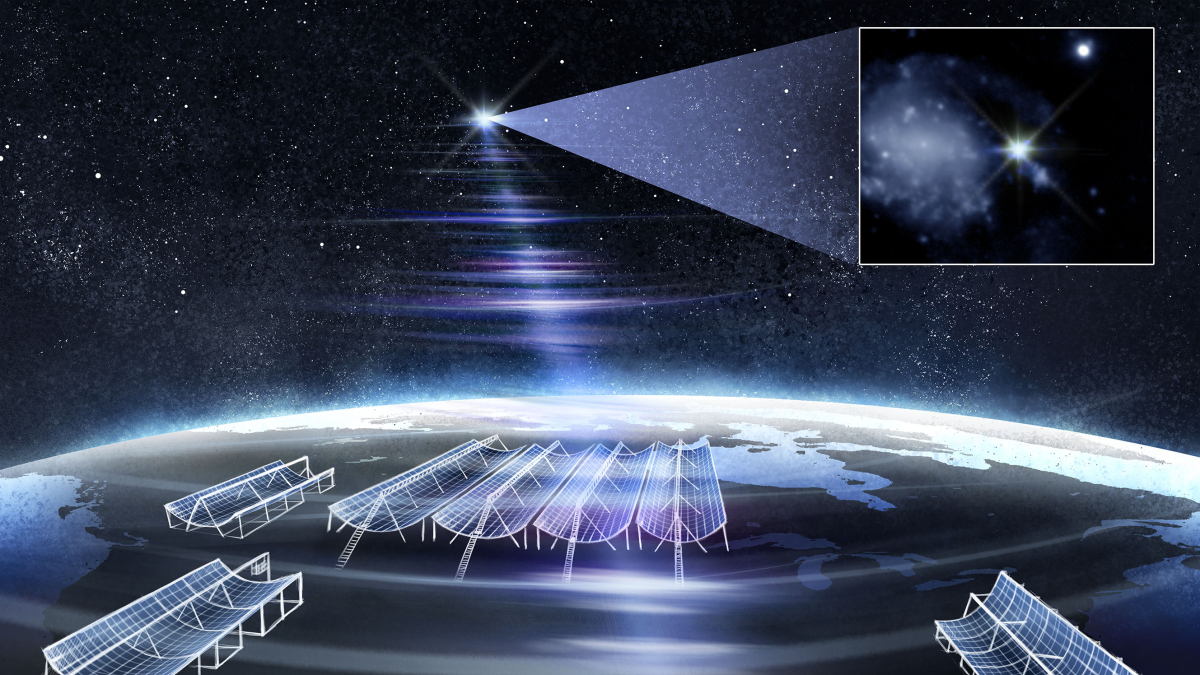Science
Astronomers Pinpoint Brightest Fast Radio Burst in Nearby Galaxy

A team of international astronomers has successfully identified one of the brightest fast radio bursts (FRBs) ever recorded, tracing it to a specific location in a nearby galaxy. This significant discovery, which took place in March 2023, has provided fresh insights into the enigmatic nature of FRBs, which have long puzzled astrophysicists due to their brief and mysterious emissions.
FRBs are intense, millisecond-long flashes of radio waves originating from deep space. Researchers believe these phenomena result from extreme cosmic events, but the exact sources have remained elusive. Their fleeting nature makes them incredibly challenging to observe, as they disappear in an instant. The Canadian Hydrogen Intensity Mapping Experiment (CHIME) has been instrumental in detecting these rare events.
The recent detection, labeled as FRB 20250316A and nicknamed “RBFLOAT” for Radio Brightest FLash Of All Time, marked a pivotal moment for researchers. For the first time, CHIME has not only detected an FRB but also pinpointed its origin, a feat that offers new avenues for exploration into the causes of these cosmic bursts.
Amanda Cook, a postdoctoral researcher at McGill University and the lead author of the study, expressed the significance of this breakthrough: “This result marks a turning point: instead of just detecting these mysterious flashes, we can now see exactly where they’re coming from. It opens the door to discovering whether they’re caused by dying stars, exotic magnetic objects, or something we haven’t thought of yet.”
Unprecedented Spatial Resolution
To determine the origin of RBFLOAT, the team utilized CHIME’s newly completed “outrigger” telescopes, which extend across North America from British Columbia to California. This network provided unprecedented spatial resolution, enabling the researchers to trace the burst to a region merely 45 light-years across, which is smaller than the average star cluster. This location resides in the outskirts of a galaxy approximately 130 million light-years away.
“The precision of this localization, tens of milliarcseconds, is like spotting a quarter from 100 kilometers away,” Cook noted. This detail allowed the team to identify the host galaxy, NGC 4141, and correlate the burst with a faint infrared signal captured by the James Webb Space Telescope.
The infrared signal revealed a mysterious source of near-infrared light exactly where RBFLOAT occurred. This unexpected finding has left researchers speculating whether the source could be a red giant star or a fading light echo from the burst itself. “The high resolution of JWST allows us to resolve individual stars around an FRB for the first time,” said Peter Blanchard, a research associate at Harvard University and the lead author of a related study. “This opens the door to identifying the kinds of stellar environments that could give rise to such powerful bursts.”
Challenging Existing Theories
Despite being the brightest FRB recorded by CHIME, researchers have not observed any repeat bursts from this source, even after hundreds of hours of observation over more than six years. This finding challenges the prevailing notion that all FRBs eventually repeat.
“It seems different energetically than the repeaters we’ve studied. We’re now re-examining some of the more explosive models that had fallen out of favor,” said Mawson Sammons, a postdoctoral researcher at McGill who collaborates with Victoria Kaspi, a prominent astrophysicist and professor at the university. Kaspi co-leads the CHIME/FRB research team, which comprises around 100 scientists.
The studies detailing these observations have been published in The Astrophysical Journal Letters. One study focuses on the radio discovery and localization of the burst, while the other examines the near-infrared images captured by the James Webb Space Telescope. Together, they provide crucial insights into the nature of FRBs and expand the potential for utilizing these cosmic signals as tools to probe the universe.
“This marks the beginning of a new era where we can routinely localize even single, non-repeating bursts to pinpoint precision,” Sammons added. “That’s a significant breakthrough for understanding what’s behind them.”
The research received support from various institutions, including the Trottier Space Institute at McGill University, the Gordon and Betty Moore Foundation, the Canada Foundation for Innovation, and the Natural Sciences and Engineering Research Council of Canada, among others. This collaboration underscores the global effort to unravel the mysteries of fast radio bursts and the profound implications they hold for astrophysics.
-

 Science4 months ago
Science4 months agoToyoake City Proposes Daily Two-Hour Smartphone Use Limit
-

 Top Stories4 months ago
Top Stories4 months agoPedestrian Fatally Injured in Esquimalt Collision on August 14
-

 Health4 months ago
Health4 months agoB.C. Review Reveals Urgent Need for Rare-Disease Drug Reforms
-

 Technology4 months ago
Technology4 months agoDark Adventure Game “Bye Sweet Carole” Set for October Release
-

 World4 months ago
World4 months agoJimmy Lai’s Defense Challenges Charges Under National Security Law
-

 Lifestyle4 months ago
Lifestyle4 months agoVictoria’s Pop-Up Shop Shines Light on B.C.’s Wolf Cull
-

 Technology4 months ago
Technology4 months agoKonami Revives Iconic Metal Gear Solid Delta Ahead of Release
-

 Technology4 months ago
Technology4 months agoApple Expands Self-Service Repair Program to Canada
-

 Technology4 months ago
Technology4 months agoSnapmaker U1 Color 3D Printer Redefines Speed and Sustainability
-

 Technology4 months ago
Technology4 months agoAION Folding Knife: Redefining EDC Design with Premium Materials
-

 Technology4 months ago
Technology4 months agoSolve Today’s Wordle Challenge: Hints and Answer for August 19
-

 Business4 months ago
Business4 months agoGordon Murray Automotive Unveils S1 LM and Le Mans GTR at Monterey









